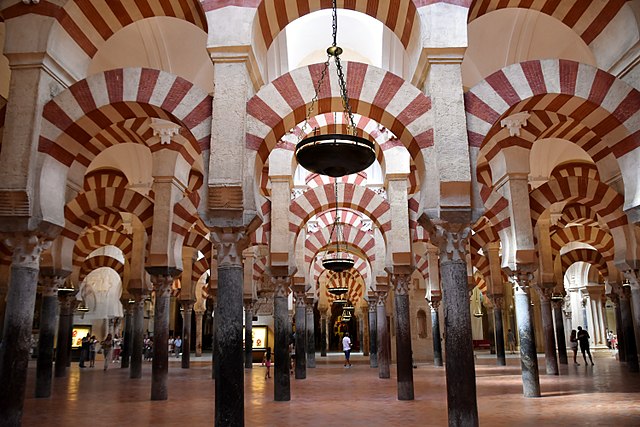Stucco decoration in Islamic architecture
Stucco decoration in Islamic architecture refers to carved or molded stucco and plaster. The terms "stucco" and "plaster" are used almost interchangeably in this context to denote most types of stucco or plaster decoration with slightly varying compositions. This decoration was mainly used to cover walls and surfaces and the main motifs were those predominant in Islamic art: geometric, arabesque, and calligraphic, as well as three-dimensional muqarnas. Plaster of gypsum composition was extremely important in Islamic architectural decoration as the relatively dry climate throughout much of the Islamic world made it easy to use this cheap and versatile material in a variety of spaces.
Stucco in the Court of the Lions of the Alhambra (14th century), in Granada, Spain. Arabesques are mixed here with calligraphic motifs and muqarnas sculpting.
Stucco dome from Khirbat al-Mafjar, late Umayyad period (early 8th century), showing Classical-inspired motifs carved in high relief
Panel of carved stucco wall decoration from Abbasid Samarra, Iraq, in the "beveled" style (9th century), showing flatter and more abstract motifs
Stucco mihrab in the Great Mosque of Isfahan in Iran, with deeply-carved arabesques and inscriptions (early 14th century, Ilkhanid)
Islamic architecture comprises the architectural styles of buildings associated with Islam. It encompasses both secular and religious styles from the early history of Islam to the present day. The Islamic world encompasses a wide geographic area historically ranging from western Africa and Europe to eastern Asia. Certain commonalities are shared by Islamic architectural styles across all these regions, but over time different regions developed their own styles according to local materials and techniques, local dynasties and patrons, different regional centers of artistic production, and sometimes different religious affiliations.
Image: Great Mosque of Cordoba, interior, 8th 10th centuries (38) (29721130342)
Image: 20180301124354 IMG 4179And 6more Interior 3
Image: Selimiye Mosque, Dome
The Mosque of the Prophet, standing on the site of Muhammad's first mosque in Medina. The present-day building is the result of many reconstructions and expansions up to modern times.








